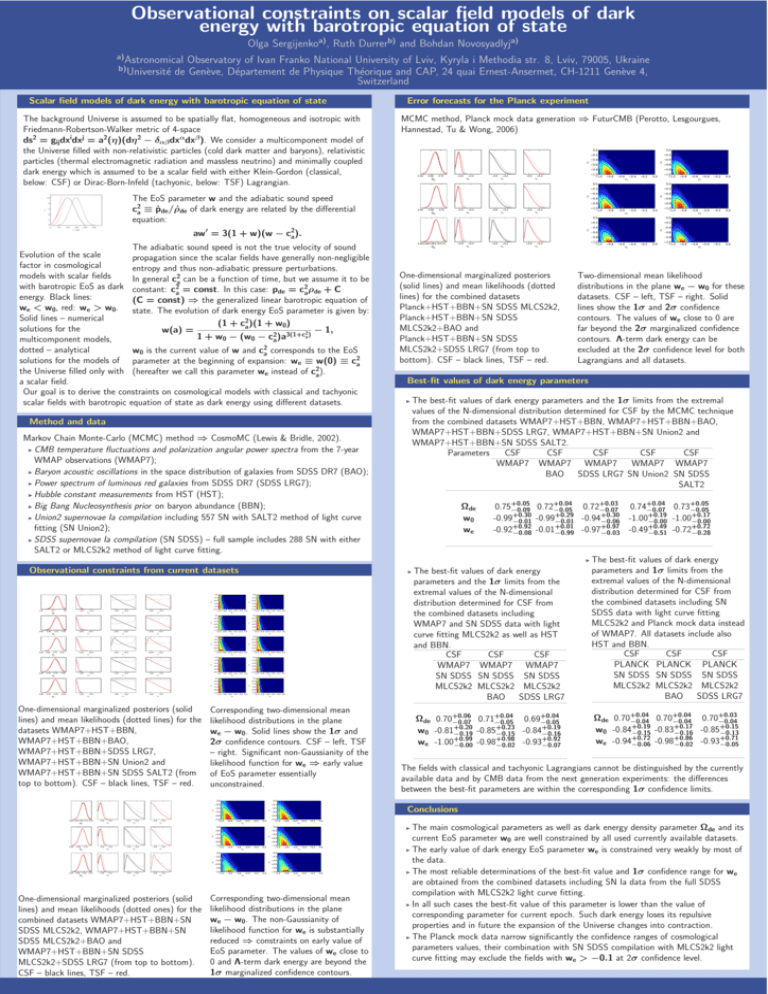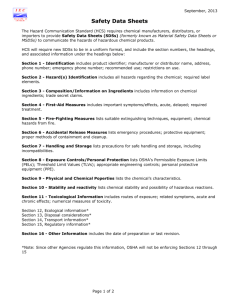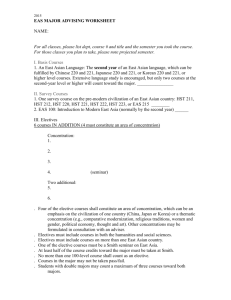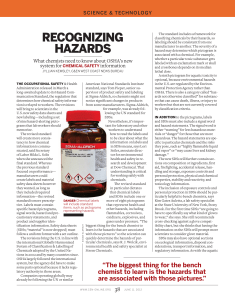Observational constraints on scalar field models of dark energy with
advertisement

Observational constraints on scalar field models of dark energy with barotropic equation of state Olga Sergijenkoa), Ruth Durrerb) and Bohdan Novosyadlyja) a) Astronomical Observatory of Ivan Franko National University of Lviv, Kyryla i Methodia str. 8, Lviv, 79005, Ukraine b) Université de Genève, Département de Physique Théorique and CAP, 24 quai Ernest-Ansermet, CH-1211 Genève 4, Switzerland MCMC method, Planck mock data generation ⇒ FuturCMB (Perotto, Lesgourgues, Hannestad, Tu & Wong, 2006) 0.68 0.72 0.8 de 0.4 w0 0.8 0.4 we 0.8 we 0.68 0.72 0.8 de 0.4 w0 0.8 0.4 we 0.8 we Observational constraints from current datasets 0.64 0.66 0.68 0.70 0.72 0.8 de 0.4 w0 0.8 0.4 we 0.8 we 0.4 0.8 w0 0.4 0.8 we 0.4 0.2 0.4 0.6 0.8 1.0 1.0 0.8 0.6 0.4 0.2 0.4 0.2 0.4 0.6 0.8 1.0 1.0 0.8 0.6 0.4 0.2 0.4 0.2 0.4 0.6 0.8 1.0 1.0 0.8 0.6 0.4 0.2 we 0.4 w0 0.0 w0 ◮ 0.64 0.68 0.72 0.8 0.76 0.4 0.8 w0 de 0.4 0.8 we we w0 0.0 w0 0.66 0.70 0.8 0.74 0.4 0.8 w0 de 0.4 0.8 we we w0 0.0 0.74 0.8 0.78 0.4 0.8 w0 de 0.4 0.8 we we w0 0.0 0.8 0.4 0.8 we we 0.60 0.64 0.68 0.72 0.76 0.8 0.4 w0 0.8 0.4 we 0.8 0.4 we we de 0.68 de 0.8 0.72 0.4 w0 0.8 0.4 we 0.8 0.4 we we 0.64 0.62 0.66 0.70 de 0.74 0.8 0.4 w0 0.8 0.4 we 0.8 0.4 we One-dimensional marginalized posteriors (solid lines) and mean likelihoods (dotted ones) for the combined datasets WMAP7+HST+BBN+SN SDSS MLCS2k2, WMAP7+HST+BBN+SN SDSS MLCS2k2+BAO and WMAP7+HST+BBN+SN SDSS MLCS2k2+SDSS LRG7 (from top to bottom). CSF – black lines, TSF – red. 0.0 0.0 w0 0.0 Corresponding two-dimensional mean likelihood distributions in the plane we − w0. Solid lines show the 1σ and 2σ confidence contours. CSF – left, TSF – right. Significant non-Gaussianity of the likelihood function for we ⇒ early value of EoS parameter essentially unconstrained. we One-dimensional marginalized posteriors (solid lines) and mean likelihoods (dotted lines) for the datasets WMAP7+HST+BBN, WMAP7+HST+BBN+BAO, WMAP7+HST+BBN+SDSS LRG7, WMAP7+HST+BBN+SN Union2 and WMAP7+HST+BBN+SN SDSS SALT2 (from top to bottom). CSF – black lines, TSF – red. w0 0.0 0.0 0.2 0.2 0.4 0.4 we 0.4 w0 0.6 0.8 1.0 1.0 1.0 1.0 0.8 0.6 w0 0.4 0.2 0.0 0.0 0.0 0.2 0.2 0.4 0.4 0.6 0.8 1.0 1.0 1.0 1.0 0.8 0.6 w0 0.4 0.2 0.0 0.0 0.0 0.2 0.2 0.4 0.4 0.6 0.8 1.0 1.0 1.0 1.0 0.6 w0 0.4 0.2 0.0 0.6 w0 0.4 0.2 we 0.2 1.0 1.0 0.0 0.0 0.2 0.2 0.4 0.4 0.6 0.8 0.6 0.4 w0 0.2 0.0 0.8 0.6 0.4 w0 0.2 0.0 0.8 0.6 0.4 w0 0.2 0.0 0.6 0.8 0.8 0.6 0.4 w0 0.2 1.0 1.0 0.0 0.0 0.0 0.2 0.2 0.4 0.4 0.6 0.6 0.8 0.8 0.6 0.4 w0 0.2 0.0 1.0 1.0 Two-dimensional mean likelihood distributions in the plane we − w0 for these datasets. CSF – left, TSF – right. Solid lines show the 1σ and 2σ confidence contours. The values of we close to 0 are far beyond the 2σ marginalized confidence contours. Λ-term dark energy can be excluded at the 2σ confidence level for both Lagrangians and all datasets. +0.05 +0.04 +0.03 +0.04 +0.05 0.73−0.05 0.74−0.07 0.72−0.07 0.72−0.05 0.75−0.09 +0.17 +0.19 +0.30 +0.29 +0.30 -1.00−0.00 -1.00−0.00 -0.94−0.06 -0.99−0.01 -0.99−0.01 +0.72 +0.49 +0.97 +0.01 +0.92 -0.92−0.08 -0.01−0.99 -0.97−0.03 -0.49−0.51 -0.72−0.28 The best-fit values of dark energy parameters and the 1σ limits from the extremal values of the N-dimensional distribution determined for CSF from the combined datasets including WMAP7 and SN SDSS data with light curve fitting MLCS2k2 as well as HST and BBN. CSF CSF CSF WMAP7 WMAP7 WMAP7 SN SDSS SN SDSS SN SDSS MLCS2k2 MLCS2k2 MLCS2k2 BAO SDSS LRG7 +0.06 Ωde 0.70−0.07 +0.20 w0 -0.81−0.19 +0.99 we -1.00−0.00 +0.04 0.71−0.05 +0.23 -0.85−0.15 +0.98 -0.98−0.02 +0.04 0.69−0.05 +0.19 -0.84−0.16 +0.92 -0.93−0.07 The best-fit values of dark energy parameters and 1σ limits from the extremal values of the N-dimensional distribution determined for CSF from the combined datasets including SN SDSS data with light curve fitting MLCS2k2 and Planck mock data instead of WMAP7. All datasets include also HST and BBN. CSF CSF CSF PLANCK PLANCK PLANCK SN SDSS SN SDSS SN SDSS MLCS2k2 MLCS2k2 MLCS2k2 BAO SDSS LRG7 +0.04 Ωde 0.70−0.04 +0.19 w0 -0.84−0.15 +0.72 we -0.94−0.06 +0.04 0.70−0.04 +0.17 -0.83−0.16 +0.86 -0.98−0.02 +0.03 0.70−0.04 +0.15 -0.85−0.13 +0.71 -0.93−0.05 The fields with classical and tachyonic Lagrangians cannot be distinguished by the currently available data and by CMB data from the next generation experiments: the differences between the best-fit parameters are within the corresponding 1σ confidence limits. 0.0 The main cosmological parameters as well as dark energy density parameter Ωde and its current EoS parameter w0 are well constrained by all used currently available datasets. ◮ The early value of dark energy EoS parameter we is constrained very weakly by most of the data. ◮ The most reliable determinations of the best-fit value and 1σ confidence range for we are obtained from the combined datasets including SN Ia data from the full SDSS compilation with MLCS2k2 light curve fitting. ◮ In all such cases the best-fit value of this parameter is lower than the value of corresponding parameter for current epoch. Such dark energy loses its repulsive properties and in future the expansion of the Universe changes into contraction. ◮ The Planck mock data narrow significantly the confidence ranges of cosmological parameters values, their combination with SN SDSS compilation with MLCS2k2 light curve fitting may exclude the fields with we > −0.1 at 2σ confidence level. ◮ 0.8 0.6 0.4 0.2 0.0 0.8 0.6 0.4 0.2 0.0 w0 0.6 0.8 0.8 0.8 0.6 0.8 0.6 0.4 w0 Conclusions 0.6 0.8 we 0.8 0.78 0.2 0.4 0.6 0.8 1.0 1.0 0.8 0.6 0.4 0.2 we 0.74 de 0.0 0.0 we we 0.70 0.2 0.4 0.6 0.8 1.0 1.0 0.8 0.6 0.4 0.2 w0 0.0 0.66 0.0 0.0 we we 0.70 0.2 0.4 0.6 0.8 1.0 1.0 0.8 0.6 0.4 0.2 w0 0.0 0.66 0.0 0.0 we we 0.0 0.62 0.2 0.4 0.6 0.8 1.0 1.0 0.8 0.6 0.4 0.2 0.8 The best-fit values of dark energy parameters and the 1σ limits from the extremal values of the N-dimensional distribution determined for CSF by the MCMC technique from the combined datasets WMAP7+HST+BBN, WMAP7+HST+BBN+BAO, WMAP7+HST+BBN+SDSS LRG7, WMAP7+HST+BBN+SN Union2 and WMAP7+HST+BBN+SN SDSS SALT2. Parameters CSF CSF CSF CSF CSF WMAP7 WMAP7 WMAP7 WMAP7 WMAP7 BAO SDSS LRG7 SN Union2 SN SDSS SALT2 Ωde w0 we 0.0 we we 0.0 0.8 Best-fit values of dark energy parameters 0.0 0.2 0.4 0.6 0.8 1.0 1.0 0.8 0.6 0.4 0.2 we 0.6 0.0 1.0 1.0 0.4 One-dimensional marginalized posteriors (solid lines) and mean likelihoods (dotted lines) for the combined datasets Planck+HST+BBN+SN SDSS MLCS2k2, Planck+HST+BBN+SN SDSS MLCS2k2+BAO and Planck+HST+BBN+SN SDSS MLCS2k2+SDSS LRG7 (from top to bottom). CSF – black lines, TSF – red. ◮ 0.4 we 0.8 0.8 0.6 1.0 1.0 0.4 we ◮ de 0.4 1.0 1.0 0.4 we 0.64 Markov Chain Monte-Carlo (MCMC) method ⇒ CosmoMC (Lewis & Bridle, 2002). ◮ CMB temperature fluctuations and polarization angular power spectra from the 7-year WMAP observations (WMAP7); ◮ Baryon acoustic oscillations in the space distribution of galaxies from SDSS DR7 (BAO); ◮ Power spectrum of luminous red galaxies from SDSS DR7 (SDSS LRG7); ◮ Hubble constant measurements from HST (HST); ◮ Big Bang Nucleosynthesis prior on baryon abundance (BBN); ◮ Union2 supernovae Ia compilation including 557 SN with SALT2 method of light curve fitting (SN Union2); ◮ SDSS supernovae Ia compilation (SN SDSS) – full sample includes 288 SN with either SALT2 or MLCS2k2 method of light curve fitting. 0.7 0.4 0.8 Method and data 0.6 0.2 0.8 The adiabatic sound speed is not the true velocity of sound Evolution of the scale propagation since the scalar fields have generally non-negligible factor in cosmological entropy and thus non-adiabatic pressure perturbations. models with scalar fields In general c2a can be a function of time, but we assume it to be with barotropic EoS as dark constant: c2 = const. In this case: pde = c2ρde + C a a energy. Black lines: (C = const) ⇒ the generalized linear barotropic equation of we < w0, red: we > w0. state. The evolution of dark energy EoS parameter is given by: Solid lines – numerical (1 + c2a)(1 + w0) solutions for the w(a) = − 1, 2 2)a3(1+ca ) 1 + w − (w − c 0 0 multicomponent models, a dotted – analytical w0 is the current value of w and c2a corresponds to the EoS solutions for the models of parameter at the beginning of expansion: we ≡ w(0) ≡ c2a the Universe filled only with (hereafter we call this parameter we instead of c2a). a scalar field. Our goal is to derive the constraints on cosmological models with classical and tachyonic scalar fields with barotropic equation of state as dark energy using different datasets. 0.2 0.4 0.6 0.8 1.0 1.0 0.8 0.6 0.4 0.2 0.2 we 0.64 aw′ = 3(1 + w)(w − c2a). 0.0 0.0 0.8 The EoS parameter w and the adiabatic sound speed c2a ≡ ṗde/ρ̇de of dark energy are related by the differential equation: 0.2 0.4 0.6 0.8 1.0 1.0 0.8 0.6 0.4 0.2 0.0 we The background Universe is assumed to be spatially flat, homogeneous and isotropic with Friedmann-Robertson-Walker metric of 4-space ds2 = gijdxidxj = a2(η)(dη 2 − δαβ dxαdxβ ). We consider a multicomponent model of the Universe filled with non-relativistic particles (cold dark matter and baryons), relativistic particles (thermal electromagnetic radiation and massless neutrino) and minimally coupled dark energy which is assumed to be a scalar field with either Klein-Gordon (classical, below: CSF) or Dirac-Born-Infeld (tachyonic, below: TSF) Lagrangian. Error forecasts for the Planck experiment we Scalar field models of dark energy with barotropic equation of state w0 Corresponding two-dimensional mean likelihood distributions in the plane we − w0. The non-Gaussianity of likelihood function for we is substantially reduced ⇒ constraints on early value of EoS parameter. The values of we close to 0 and Λ-term dark energy are beyond the 1σ marginalized confidence contours.







